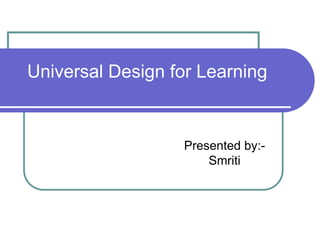
Universal design-for-learning
- 1. Universal Design for Learning Presented by:- Smriti
- 2. What is Universal Design for Learning? Universal Design for Learning, or UDL, is an instructional approach that opens opportunities for all students by using digital media and flexible instruction to help students meet their educational goals.
- 3. Universal Design History Universal design began as an architectural movement in the USA. Curb cuts, automatic doors and ramps were added to buildings during the design process rather than as an after-thought. The concept of universal design has also been applied to web page designs which enable users with special needs to access the internet. More recently universal design has been applied to education. UDL has entered the educational world at this point in time because the technology is more available making UDL possible.
- 5. Universal Design in Architecture and Products Curb Cuts Ramps Captions on TV Elevators Easy Grip Tools .
- 6. UDL UDL provides equal access to learning, not simply equal access to information. Universal Design allows the student to control the method of accessing information while the teacher monitors the learning environment.
- 7. UDL UDL has its basis in neuroscience; the three principles correlate with the three networks in the brain which must be simultaneously engaged for optimal learning to occur.
- 8. Who Benefits? Students who speak English as a second language International students Students with disabilities Students with different learning styles Students with varying academic abilities Students with complex medical needs
- 9. UDL continued UDL principles make education more inclusive and effective by removing the barriers from the learning process. If we design curriculum following the principles of UDL, we effectively remove the need for “special accommodations”
- 10. Three Key Principles of UDL Multiple means of presentation Multiple means of expression Multiple means of engagement
- 11. Multiple Means of Representation Universally designed course content provides alternative presentations of essential concepts. Various methods of presentation can allow the student to learn the information in their preferred method.
- 12. How does this look in a classroom? Content could be presented using multiple media, such as oral lectures, textbooks, charts or diagrams, audio tapes, and videos. The same content could be changed from one medium to another, such as oral output for students with reading difficulties or pictures and illustrations for students who need a visual image.
- 13. Multiple Means of Engagement Universally designed course content maintains varied skill levels, preferences, and interests by allowing for options. Having flexible teaching strategies and course content, students can choose methods that support their interest and skill levels. Tap into students’ interests.
- 14. How does this look in a classroom? Students would choose their preferred method of learning new material. One child might learn vocabulary by playing a game in a race against the clock; another might create stories or even artwork to incorporate the new words.
- 15. Materials would provide extra support where students need it. For reading practice, independent readers could read silently from a book. Students needing more support might read computer-based stories where they could click on a troublesome word to hear it pronounced or have the entire text read aloud.
- 16. UDL Assignments could be varied according to each child's skills. If the goal of a project is to learn research skills, more advanced students might be required to produce a longer report or cite more references. Students with less developed research skills might gain as much from creating a report using fewer references to cover a limited number of key points.
- 17. Offer choices of learning context Offer choices of content and tools Offer adjustable levels of challenge Offer multiple ways to be successful
- 18. Multiple Means of Expression Universally designed course content allows for alternate methods of expression. Allow students multiple means of demonstrating mastery of the material.
- 19. How does this look in a classroom? Assignments would be accepted in various formats. A student who finds written expression difficult might show his knowledge orally; another might turn in a report, write a play, or develop a project to demonstrate learning.
- 20. UDL “Paper and pencil" exercises could become "computer and printer" exercises for students who are slowed down by the physical effort of writing, or for any student who prefers using a keyboard.
- 21. UDL Provide opportunities to practice with support Provide opportunities for group discussion Provide cooperative learning opportunities Allow opportunities for oral presentations
- 22. All the brain networks engaged simultaneously
- 23. In Summary: UDL occurs when teachers plan instruction and curricula that address the needs of all students, regardless of their learning, behavioral, or physical challenges Increases in digital technology has created an environment where UDL is now possible. Together , UDL and is paving the way for more accessible classes for all
